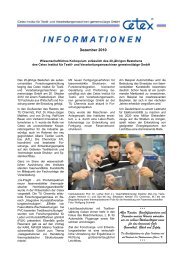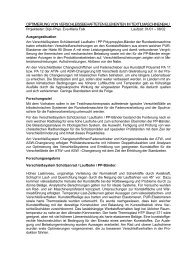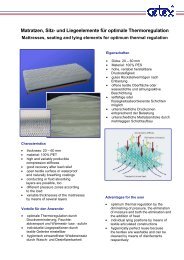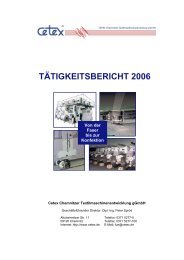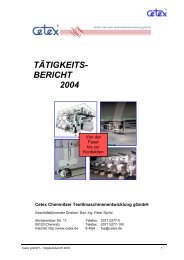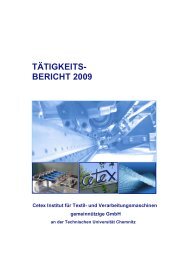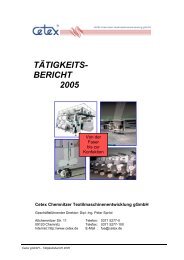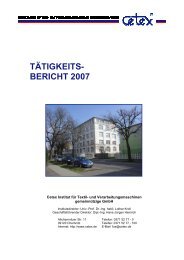Funktionelle Textilien - Cetex Institut für Textil
Funktionelle Textilien - Cetex Institut für Textil
Funktionelle Textilien - Cetex Institut für Textil
Create successful ePaper yourself
Turn your PDF publications into a flip-book with our unique Google optimized e-Paper software.
In early history already, textile technology<br />
and textile machine construction<br />
supplied the foundations for technical<br />
progress and until today they are the<br />
incubator of many innovations.<br />
If in the beginnings, human societies<br />
needed to protect themselves from cold<br />
and wetness, in later times, better qualities<br />
and larger item numbers were produced.<br />
New production processes were<br />
launched.<br />
Clothing of the future can even do much<br />
more: computer chips in one’s clothing<br />
for instance are to make the life of people<br />
easier and safer. Today, the German<br />
clothing industry is already leading the<br />
field of such intelligent textiles. This position<br />
can only be expanded by constantly<br />
churning out new innovative<br />
products.<br />
But the fields of application of textiles<br />
go much further than this. Now the<br />
issue is about integrating classical textile<br />
materials and their processing methods<br />
to find new textile materials to use<br />
the many favourable properties in later<br />
technical applications. All textiles that<br />
do not serve to clothe humans and are<br />
intended for technical purposes are<br />
technical textiles. These textile materials<br />
often render effects in technical applications<br />
that are unattainable with<br />
other materials (for example as renew-<br />
able primary products or with the selfcleaning<br />
Lotus effect). With the new<br />
fibres increased strengths are achieved<br />
that are unthinkable with common, often<br />
metallic materials, and that additionally<br />
have own weights that are markedly<br />
below that of metals.<br />
In the course of time, many fields of<br />
application have crystallized:<br />
• vehicle technology (automobile,<br />
aviation and space industry,<br />
railways, shipbuilding)<br />
• process technology<br />
(pipeline, filters, sealing gaskets)<br />
• occupational safety<br />
(reflective clothing,<br />
heat protection, sting protection)<br />
• medical engineering<br />
(implants, surgical dressing)<br />
• agricultural technology (soil irrigation<br />
and drainage, plant vessels)<br />
• structural engineering<br />
(road construction, roof covering,<br />
climate control)<br />
• transport and warehouse technology<br />
(canvas covers, conveyor belts,<br />
big bags)<br />
and for<br />
• the fields of sport and leisure (sport<br />
equipment and assisting devices)<br />
• industrial supplies (cylinder lining,<br />
insulating materials, fuel resources)<br />
• environmental protection<br />
(recycling, landscaping)<br />
<strong>Textil</strong>e Technology<br />
• home textiles<br />
(floor covering, light shield).<br />
Today, the share of technical textiles<br />
contained in the overall turnover generated<br />
by the German textile industry<br />
amounts to over 35 per cent. Serious<br />
forecasts estimate that the growth rate<br />
will additionally increase annually by at<br />
least 3.5 per cent until 2010.<br />
All these new fields of application require<br />
machine engineering for production<br />
as well as testing and measuring<br />
technology for determining the quality<br />
standards to be achieved. Researchers<br />
and machine engineers are confronted<br />
with high requirements in terms of the<br />
gentle treatment of completely new hightech<br />
fibres, a flexible adjustment to new<br />
products as well as user-friendly working<br />
procedures. The creation of a fibre<br />
featuring composite structures for instance<br />
and adjusting process engineering<br />
to the composite structure can only<br />
lead to success after the practical<br />
use of modern computing and drive<br />
technology systems has been implemented.<br />
These high technologies also demand a<br />
new treatment of fibres for lightweight<br />
construction. Especially the aviation industry<br />
has influenced the creation and<br />
application of new technologies to a<br />
85



